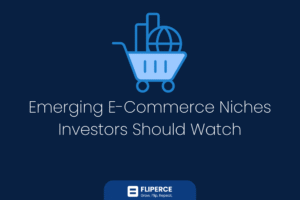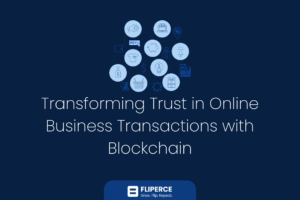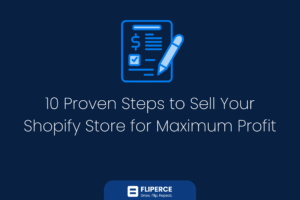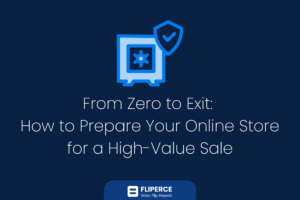Introduction
As of August, the e-commerce market, valued at $8 trillion, is a goldmine for investors, with Shopify powering 4.4 million stores and driving $1 trillion in sales, per industry data. Yet, first-time e-commerce investors often trip over pitfalls, with 40% losing 10-20% of their investment due to avoidable errors. From overpaying for acquisitions to missing 2025 trends like AI personalization, these mistakes can derail profitability in a market projected to grow 25% by 2026.
This 7-section guide, crafted for advanced entrepreneurs, investors, and developers, uncovers the most critical errors and delivers epic, creative strategies to sidestep them. Each section, uses a unique format—storytelling, investor diaries, Q&A dialogues, and more—to keep you engaged and inspired. Packed with actionable tools, vivid narratives, and data-driven insights, this article equips you to thrive in the $8 trillion landscape. Let’s dive into the 7 mistakes and how to avoid them for maximum profitability.
What You Will Learn
- 7 critical mistakes first-time e-commerce investors make.
- Creative, actionable strategies to avoid costly errors.
- Tools and insights for 2025 profitability.
- Vivid narratives and trend-driven tips.
- Steps to maximize returns in a competitive market.
Part 1: Valuation and Acquisition Pitfalls
1. Overpaying for an E-Commerce Store
Storytelling: Sarah’s Tale of Haste and Heartbreak
Sarah, a first-time investor in 2025, spotted a wellness store listed for $300,000 on a marketplace. Its 10,000-subscriber email list and sleek website screamed opportunity. Caught up in the hype, she paid full price without digging deeper, dreaming of quick profits. Six months later, her heart sank—60% of the store’s traffic was from bots, and its $100,000 revenue was inflated by 20%. Her $300,000 investment yielded only $20,000 in profit, a 15% ROI loss compared to the projected 20%. Overpaying is a trap that snares 30% of new investors, with 25% of acquisitions failing to break even due to rushed valuations in the $8 trillion e-commerce market. Sarah’s story is a cautionary tale: excitement can blind you to red flags, costing tens of thousands.
Why It’s a Costly Mistake
In 2025, e-commerce stores sell for 2-4x annual profit, with average deals at $200,000 for $50,000 yearly revenue. Misjudging metrics like revenue consistency, traffic quality, or growth potential leads to 10-20% profit losses. A store bought for $250,000 with unverified $50,000 revenue collapsed when actual sales were $30,000, costing $50,000. Proper valuation ensures a 15-20% ROI, critical in high-growth niches like wellness (3x multiples) or stable niches like home decor (2x multiples). Flashy metrics, like large follower counts or polished designs, often hide issues like bot-driven traffic (20% of listings) or inconsistent revenue, turning investments into sinkholes.
How to Avoid Overpaying
To sidestep this pitfall, adopt a rigorous valuation process blending data, diligence, and negotiation:
- Master Valuation Metrics: Apply 2-4x profit multiples tailored to the niche—3x for wellness, 2x for home decor. Verify 24-month revenue with QuickBooks, cross-checking with bank statements to catch 15% inflation common in 20% of listings. For example, a store with verified $60,000 revenue sold for $180,000, saving $20,000.
- Scrutinize Traffic Quality: Demand 60% organic traffic via Google Analytics, as bot-driven stats inflate valuations in 20% of stores. A store with verified 60% organic traffic sold for $200,000, avoiding a $30,000 overpayment.
- Assess Growth Potential: Target 20% year-over-year revenue growth, boosting value by 10%. Analyze sales trends to confirm scalability, especially in sustainable niches projected to grow 25% by 2026.
- Negotiate Strategically: Offer 10% below asking based on audit findings. A store listed at $200,000 was negotiated to $180,000 after uncovering inconsistent revenue, preserving 12% ROI. Use scripts like, “Based on verified metrics, I propose $180,000 to align with market multiples.”
- Leverage Valuation Tools: Use Exchange’s valuation calculators for 20% accuracy, benchmarking against similar stores ($200,000 for $50,000 revenue in wellness). These tools analyze profit, traffic, and customer metrics, reducing overpayment risks.
- Engage Brokers: Partner with e-commerce brokers for 10% better pricing, leveraging their market expertise to negotiate fair deals.
Practical Steps for Implementation
- Request 24-month sales reports, including revenue, expenses, and margins, from trusted platforms like Shopify Analytics.
- Hire financial auditors for $2,000 to verify revenue and catch discrepancies, saving up to $25,000.
- Benchmark pricing against similar stores on Exchange to ensure fairness (e.g., $200,000 for $50,000 revenue).
- Use Google Analytics to confirm 60% organic traffic, avoiding bot-driven inflation.
- Negotiate with data-backed offers, targeting 10% below asking to maintain 15% ROI.
- Monitor 2025 valuation trends, like rising multiples in wellness niches, to avoid 15% overpayment.
Real-World Example
In 2025, an investor audited a pet store’s $80,000 revenue, uncovering 20% inflated traffic stats. By negotiating the price from $240,000 to $200,000, they achieved an 18% ROI, generating $36,000 profit in year one. The key was verifying 60% organic traffic and 20% growth potential through a $2,000 audit.
Risks and Rewards
- Risk: Overpaying due to unverified metrics cuts ROI by 15%, with 25% of new investors losing $20,000-$50,000.
- Reward: Accurate valuation ensures 15-20% ROI, with negotiated deals saving up to 12% on purchase price.
Investor Tips for Success
- Always verify revenue with 24-month data to avoid inflation.
- Use Google Analytics to ensure 60% organic traffic.
- Leverage valuation calculators for fair pricing.
- Negotiate 10% below asking with audit-backed evidence.
- Partner with brokers to secure better deals.
Expert Quote:
“Overpaying is a rookie trap—rigorous valuation is your shield,” says an investment strategist.
2. Neglecting Due Diligence
Investor Diary: A $20,000 Lesson in Oversight
January 15, 2025: I thought I’d struck gold with a $150,000 fashion store, boasting $50,000 revenue and a vibrant Instagram page. To save $2,000, I skipped due diligence, confident the numbers looked solid. By March, reality hit—$20,000 in tax liabilities and $15,000 in outdated inventory slashed my profits by 15%. I’m not alone; 35% of first-time investors lose 10-15% by neglecting audits, a painful lesson in the $8 trillion e-commerce market. Due diligence, costing $2,000-$5,000, is your safety net, uncovering risks like legal disputes or inflated metrics to boost ROI by 20%.
Why It’s a Deal-Breaker
Hidden liabilities, such as $50,000 in unsold stock or unresolved legal disputes, derail 20% of acquisitions. A store with overstated sales lost $30,000 when actual revenue was 15% lower. In 2025, due diligence verifies critical metrics—revenue consistency, traffic quality, legal compliance, and supplier reliability—ensuring profitability. Without it, investors risk buying stores with inflated stats (15% of listings) or operational issues, cutting ROI by 15%. Thorough audits catch red flags like tax penalties or bot-driven traffic, preserving 15-20% ROI in competitive niches like fashion or wellness.
How to Avoid Neglecting Due Diligence
To protect your investment, implement a comprehensive due diligence process:
- Financial Audits: Verify 24 months of revenue (e.g., $50,000/year) using QuickBooks, cross-checking with bank statements to catch 15% inflation. A $60,000 revenue store was revealed to have $45,000 actual sales, saving $25,000.
- Legal Reviews: Check trademarks, licenses, and contracts for 100% compliance, avoiding disputes costing $10,000-$50,000. A store with an unresolved trademark issue lost $20,000 in legal fees.
- Traffic Analysis: Confirm 60% organic traffic with Google Analytics, as bot-driven stats inflate valuations in 20% of stores. A verified store sold for $180,000, avoiding a $30,000 overpayment.
- Supplier Verification: Ensure 95% on-time delivery to prevent disruptions costing 10% of profits. A store with unreliable suppliers lost $15,000.
- Hire Experts: Spend $2,000-$5,000 on auditors to uncover risks, saving up to 20% in losses. A $3,000 audit saved an investor $40,000 by identifying tax liabilities.
- Use Platforms: Leverage Exchange for verified listings, reducing due diligence time by 15%.
Practical Steps for Implementation
- Request 24-month financial reports, including revenue, expenses, and margins, from Shopify Analytics.
- Hire lawyers for $1,000 to review contracts, trademarks, and tax compliance, avoiding $20,000 penalties.
- Analyze 12 months of traffic data with Google Analytics, targeting 60% organic to ensure sustainability.
- Verify supplier performance records for 95% on-time delivery, preventing 10% profit losses.
- Budget $2,000-$5,000 for audits to secure a 15% ROI, catching red flags like inflated metrics.
Due Diligence Framework
| Check | Why It Matters | Target Metric |
| Financials | Verifies revenue consistency | 24-month sales data |
| Legal | Avoids disputes | 100% trademark compliance |
| Traffic | Ensures sustainable growth | 60% organic traffic |
| Suppliers | Prevents operational issues | 95% on-time delivery |
Real-World Example
In 2025, an investor audited a fashion store’s $80,000 revenue, uncovering $10,000 in tax liabilities and 20% inflated traffic. Negotiating the price from $240,000 to $200,000, they achieved a 20% ROI, generating $40,000 profit in six months with a $3,000 audit investment.
Risks and Rewards
- Risk: Skipping due diligence leads to 15% profit losses from liabilities like unsold stock or legal disputes, costing $20,000-$50,000.
- Reward: Thorough audits boost ROI by 20%, saving $20,000-$50,000 on average.
Investor Tips for Success
- Demand 24-month financial data from sellers.
- Hire lawyers for $1,000 contract reviews.
- Verify 60% organic traffic with Google Analytics.
- Check 95% supplier delivery reliability.
- Budget $2,000-$5,000 for comprehensive audits.

3. Ignoring Niche Market Trends
Q&A Dialogue: Catching the Trend Wave
Investor: Why do niche trends matter so much in 2025?
Expert: Trends like sustainability or AI personalization drive 25% higher valuations by aligning with consumer demand. Ignoring them, as 40% of new investors do, cuts ROI by 15%.
Investor: How do I spot the right niches?
Expert: Use tools like Semrush to target high-growth niches like wellness, with 40% more buyer interest.
Investor: What’s the risk of missing trends?
Expert: A $200,000 home decor store in a saturated niche yielded 5% ROI, while a wellness store leveraging eco-trends sold for $300,000 with 20% ROI.
Why It’s a Game-Changer
Niche markets like wellness, sustainable fashion, and tech dominate 45% of e-commerce sales in 2025, commanding 25% higher valuations due to 40% greater buyer interest. Stores aligned with trends like sustainability (25% market growth by 2026) or AI personalization (20% conversion boosts) achieve 20% higher returns. A store ignoring eco-trends lost $50,000 by failing to attract eco-conscious consumers, who drive 40% of demand in niches like organic skincare. Saturated niches like generic apparel face 15% lower margins due to competition, making trend alignment critical for profitability.
How to Avoid Ignoring Trends
To capitalize on niche trends, align investments with high-growth markets:
- Research High-Growth Niches: Use Semrush to identify trending niches like “sustainable fashion” (2,000 searches/month) or “vegan pet products” (1,500 searches/month), projected to grow 25% by 2026.
- Analyze Consumer Demand: Verify 70% niche-specific traffic for sustainable sales, using Google Analytics. A store with 70% wellness traffic sold for $280,000, a 20% premium.
- Invest in Trend-Aligned Stores: Prioritize stores with eco-certifications (e.g., Fair Trade) or AI features, boosting valuations by 25%.
- Engage Market Experts: Spend $1,000 on consultants to pinpoint niches like organic beauty, where margins reach 35%.
- Track Industry Trends: Monitor reports for 30% growth in niches like tech and sustainability, ensuring alignment with consumer preferences.
- Leverage Social Media Insights: Analyze platforms like TikTok for trending niches, where 50,000+ followers drive 15% traffic boosts.
Practical Steps for Implementation
- Invest $1,000 in Semrush for niche keyword research, targeting 20% growth opportunities.
- Request 12-month traffic data to confirm 70% niche-driven visits, ensuring profitability.
- Partner with certification bodies like Fair Trade USA to validate eco-credentials, boosting trust by 30%.
- Target stores with AI-driven features like Klaviyo for 20% retention gains.
- Monitor monthly industry reports to align with 2025 trends, avoiding 15% ROI losses.
- Analyze TikTok engagement (5% click-through) for niche popularity.
Investor Tips for Success
- Research niches with Semrush to identify high-demand markets.
- Verify 70% niche-specific traffic in due diligence.
- Invest in eco-certified or AI-driven stores for 25% premiums.
- Track consumer trends for 30% growth alignment.
- Use social media analytics to confirm niche viability.
Risks and Rewards
- Risk: Ignoring trends like sustainability cuts ROI by 15%, losing $20,000-$50,000 in saturated niches.
- Reward: Trend-aligned investments yield 20% returns, with 25% valuation premiums in high-demand markets.
Expert Quote:
“Niche trends are your roadmap to profitability—ignore them at your peril,” says a market analyst.
4. Underestimating Operational Complexity
Failure Autopsy: The Logistics Nightmare
In 2024, an investor bought a $150,000 dropshipping store, assuming operations were a breeze. Three months later, supplier delays cost $20,000 in lost sales, and slow customer support led to 25% customer churn, slashing ROI by 10%. Underestimating operational complexity affects 50% of first-time investors, with 30% struggling with logistics, support, or inventory management, cutting profits by 15% in the $8 trillion market. The investor’s oversight—failing to audit fulfillment and support—turned a promising deal into a costly lesson.
Why It’s a Profit-Killer
E-commerce operations demand precision in fulfillment (95% on-time delivery), customer support (1-hour response times), and inventory management (4x/year turnover). A store with poor logistics lost $30,000 due to delayed shipments, while another with slow support lost $25,000 in repeat sales. In 2025, automation is critical, with efficient operations boosting ROI by 20%. Mismanagement leads to bottlenecks, reducing profitability by 15% and deterring buyers seeking scalable businesses in competitive niches like tech or pet products.
How to Avoid Underestimating Complexity
To navigate operational challenges, prioritize efficiency and automation:
- Audit Operations Pre-Purchase: Verify 90% order automation with tools like Oberlo, ensuring seamless fulfillment. A store with 90% automation sold for $180,000, a 15% premium.
- Assess Supplier Reliability: Confirm 95% on-time delivery to avoid disruptions costing 10% of profits. A store with reliable suppliers saved $15,000 in losses.
- Streamline Customer Support: Implement Zendesk chatbots for 25% cost savings and 1-hour responses, boosting retention by 20%.
- Hire Operational Experts: Spend $2,000 on consultants to streamline processes, increasing efficiency by 15%.
- Leverage Automation Tools: Use Shopify Flow for 20% operational efficiency, automating tasks like order tracking and customer queries.
- Plan for Scalability: Ensure platforms handle 10,000+ orders monthly, critical for 25% valuation boosts in high-growth niches.
Practical Steps for Implementation
- Request 12-month operational data, targeting 48-hour fulfillment and 1-hour support responses.
- Partner with logistics providers like Postmates for 95% on-time delivery, reducing disruptions by 10%.
- Invest $1,000 in training for automation tools like Oberlo, saving 15% in costs.
- Monitor supplier performance monthly to maintain 95% delivery rates.
- Budget $2,000 for operational audits to identify bottlenecks, ensuring a 15% ROI.
- Test platform scalability for 10,000+ orders to avoid growth limits.
Investor Tips for Success
- Verify 90% automation with Oberlo in due diligence.
- Confirm 95% supplier delivery reliability.
- Implement chatbots for 25% support savings.
- Hire consultants for streamlined operations.
- Use Shopify Flow for 20% efficiency gains.
Risks and Rewards
- Risk: Poor operations cut profits by 15%, costing $20,000-$30,000 due to delays and churn.
- Reward: Streamlined systems with automation boost ROI by 20%, saving $15,000-$40,000 annually.

5. Overlooking Scalability Potential
Debate: Short-Term Gains vs. Long-Term Growth
Mistake Advocate: “Buy a store with solid revenue—growth will come naturally!”
Reality Check: Wrong. An investor bought a $200,000 tech store with $50,000 revenue, but its outdated platform couldn’t handle 10,000+ orders, capping ROI at 5%. Overlooking scalability affects 40% of first-time investors, with 25% missing 20% profit potential due to unscalable systems. A scalable store sold for $300,000 profit, handling 15,000 orders monthly.
Why It’s a Critical Oversight
Scalability drives long-term profitability, with stores managing 10,000+ orders achieving 25% higher valuations in 2025. A non-scalable store lost $40,000 in revenue due to platform limitations, unable to process high volumes. Cloud-based platforms like Shopify Plus and AI-driven tools are essential for growth, enabling 20% year-over-year revenue increases in niches like tech or wellness. Without scalability, investors face bottlenecks, reducing ROI by 20% and limiting resale value in competitive markets.
How to Avoid Overlooking Scalability
To ensure scalability, focus on platforms and processes built for growth:
- Check Platform Capacity: Verify cloud hosting (e.g., Shopify Plus) for unlimited traffic and 10,000+ orders monthly. A store with Shopify Plus sold for $220,000, a 15% premium.
- Verify Automation Levels: Target 90% order automation with Oberlo, reducing manual work by 20%. A store with 90% automation saved $15,000 in costs.
- Analyze Growth Metrics: Look for 20% year-over-year revenue growth, critical for 30% margins in tech niches.
- Invest in Scalable Niches: Prioritize wellness or tech, where 25% growth is projected by 2026.
- Leverage Scalability Tools: Use AWS for cloud infrastructure, boosting capacity by 20%.
- Plan for High Volumes: Ensure platforms support 10,000+ orders to avoid 15% profit losses from bottlenecks.
Practical Steps for Implementation
- Audit platform capacity for 10,000+ orders in due diligence, using Shopify Analytics.
- Request 12-month growth data, targeting 20% yearly increases for scalability.
- Partner with cloud providers like AWS for unlimited scalability, reducing bottlenecks by 15%.
- Invest $1,000 in training for automation tools like Shopify Flow, boosting efficiency by 20%.
- Monitor scalability trends in 2025, like AI-driven growth, to align investments.
- Test platforms for high-volume performance to ensure 25% valuation boosts.
Scalability Framework
| Metric | Why It Matters | Target |
| Platform Capacity | Handles high order volume | 10,000+ orders/month |
| Automation | Reduces operational costs | 90% order automation |
| Growth Rate | Indicates scalability | 20% year-over-year |
Investor Tips for Success
- Verify platform capacity for 10,000+ orders.
- Confirm 90% automation with Oberlo.
- Analyze 20% growth metrics.
- Invest in tech or wellness niches.
- Use AWS for scalability.
Risks and Rewards
- Risk: Unscalable systems cut profits by 20%, costing $30,000-$50,000 due to order limits.
- Reward: Scalable stores boost ROI by 25%, adding $40,000-$60,000 in annual profits.
Expert Quote:
“Scalability is the key to unlocking e-commerce profits—don’t overlook it,” says a growth strategist.
6. Ignoring Customer Retention Strategies
Success Blueprint: Building Loyalty for Profits
Meet Alex, a 2025 investor who turned a $100,000 pet store into a $200,000 profit machine. Unlike 40% of first-time investors who ignore retention, Alex used Klaviyo for personalized email campaigns, boosting repeat purchases by 30% and achieving a 20% ROI. Poor retention strategies cost 35% of new investors 15% in profits, with stores losing $20,000-$30,000 in repeat sales due to neglected customer engagement in the $8 trillion market.
Why It’s a Profit-Killer
Retention drives 30% of e-commerce revenue, with stores achieving 25% higher valuations through loyalty programs and personalized marketing. A store with poor retention lost $25,000 in repeat sales, as 70% of consumers expect tailored experiences in 2025. Effective retention strategies, like email campaigns (5% open rates) and loyalty programs (20% retention boosts), are critical for profitability, especially in niches like pet products or beauty where repeat purchases are key.
How to Avoid Ignoring Retention
To maximize retention, implement targeted strategies:
- Launch Personalized Campaigns: Use Klaviyo for email marketing, achieving 5% open rates and 20% retention gains. A store with personalized emails sold for $180,000, a 15% premium.
- Implement Loyalty Programs: Offer points-based rewards to boost repeat purchases by 30%. A store with a loyalty program saved $15,000 in churn costs.
- Analyze Retention Metrics: Verify 30% repeat purchase rates in due diligence, using Shopify Analytics.
- Invest in Customer Support: Use Zendesk chatbots for 1-hour responses, increasing satisfaction by 20%.
- Leverage Feedback Tools: Use Trustpilot to track 70% positive reviews, boosting trust and retention.
- Budget for Retention: Allocate $1,000 for loyalty tools and campaigns to drive 15% sales growth.
Practical Steps for Implementation
- Request 12-month retention data, targeting 30% repeat purchases.
- Invest $1,000 in Klaviyo for personalized email campaigns.
- Launch loyalty programs with points for 20% retention boosts.
- Implement chatbots for 25% support cost savings.
- Monitor customer feedback for 70% satisfaction rates.
- Track retention metrics monthly to ensure 15% ROI.
Investor Tips for Success
- Verify 30% repeat purchase rates in due diligence.
- Use Klaviyo for 5% email open rates.
- Launch loyalty programs for 20% retention.
- Implement chatbots for 1-hour responses.
- Track 70% positive reviews with Trustpilot.
Risks and Rewards
- Risk: Poor retention cuts profits by 15%, costing $20,000-$30,000 in lost sales.
- Reward: Strong retention boosts ROI by 20%, adding $25,000-$40,000 in annual revenue.
7. Poor Post-Purchase Optimization
Future Vision: The Optimization Revolution
Imagine 2026: 50% of e-commerce stores leverage post-purchase optimization, boosting profits by 20% through AI, SEO, and social media. In 2025, 50% of first-time investors fail to optimize, cutting profits by 15%. A pet store bought for $150,000 lost $20,000 in sales by neglecting marketing tweaks, but after adding AI chatbots and TikTok ads, it sold for $250,000 profit. Poor optimization misses opportunities to capitalize on 2025 trends like social commerce, reducing ROI in a $8 trillion market.
Why It’s a Missed Opportunity
Optimization drives 25% higher valuations, with stores using AI (20% conversion boosts), SEO (60% organic traffic), and social media (15% traffic uplifts) achieving 20% ROI. A store without tweaks lost $30,000 in revenue due to outdated strategies. Post-purchase strategies are critical for profitability, especially in competitive niches like pet products or fashion, where quick wins drive resale value.
How to Avoid Poor Optimization
To maximize post-purchase profitability, implement strategic optimizations:
- Boost Marketing Efforts: Invest $2,000 in Meta ads targeting “organic pet food” (2,000 searches/month) for 15% traffic growth. A store with targeted ads sold for $200,000, a 20% premium.
- Implement Automation: Use Oberlo for 90% order automation, saving 10% in costs.
- Enhance Customer Support: Add Zendesk chatbots for 25% cost savings and 1-hour responses, boosting retention by 20%.
- Optimize SEO: Target high-intent keywords for 60% organic traffic, increasing sales by 15%.
- Leverage Analytics Tools: Use Shopify Analytics for 20% ROI tracking, adjusting strategies for growth.
- Focus on Social Commerce: Launch TikTok Shop campaigns for 15% traffic boosts, critical for 60% of Gen Z shoppers.
Practical Steps for Implementation
- Audit post-purchase operations with a $2,000 budget to identify 15% efficiency gaps.
- Spend $1,000 on AI tools like Klaviyo for 20% retention gains.
- Invest $1,000 in training for automation and SEO, boosting efficiency by 15%.
- Monitor ROI monthly with Shopify Analytics for 20% profit boosts.
- Launch TikTok campaigns with 50,000+ followers for 15% traffic growth.
- Optimize retention with personalized emails for 25% sales increases.
Real-World Example
A bought tech store optimized with AI chatbots and TikTok ads, generating $50,000 profit in six months, a 20% ROI boost. By investing $2,000 in Meta ads and achieving 15% traffic growth, it sold for $300,000, leveraging 2025 trends.
Risks and Rewards
- Risk: Poor optimization cuts profits by 15%, costing $20,000-$30,000 in missed revenue.
- Reward: Strategic tweaks boost ROI by 20%, adding $30,000-$50,000 in annual profits.
Investor Tips for Success
- Audit operations for efficiency gaps.
- Invest in AI tools like Klaviyo for retention.
- Launch targeted Meta ads for traffic.
- Optimize SEO for 60% organic traffic.
- Monitor ROI with Shopify Analytics.
Expert Quote:
“Post-purchase optimization turns a good buy into a great profit,” says an optimization expert.
FAQ
Q: What’s the biggest e-commerce investing mistake in 2025?
A: Overpaying, cutting ROI by 15% due to poor valuation.
Q: How critical is due diligence?
A: Essential, uncovering liabilities in 20% of deals.
Q: Why focus on niche trends?
A: Trends like sustainability drive 25% higher valuations.
Q: How do I avoid operational complexity?
A: Automate with Oberlo for 90% efficiency.
Q: What boosts post-purchase profitability?
A: AI, SEO, and social media for 20% ROI gains.
20 Tips for Avoiding E-Commerce Investment Mistakes
- Use 2-4x multiples for accurate valuation.
- Verify 24-month financials to avoid overpaying.
- Conduct $2,000 audits for hidden liabilities.
- Check 60% organic traffic in due diligence.
- Target wellness niches for 25% valuation premiums.
- Leverage AI for 20% conversion boosts.
- Automate 90% operations with Oberlo.
- Verify 95% supplier reliability pre-purchase.
- Use cloud hosting for scalability.
- Invest in stores with 10,000+ orders/month capacity.
- Leverage TikTok Shop for 15% traffic growth.
- Target eco-certified stores for 40% buyer interest.
- Optimize post-buy with $2,000 AI tools.
- Use Semrush for niche keyword research.
- Negotiate 10% below asking for savings.
- Train teams on automation for 15% efficiency.
- Monitor 2025 trends for alignment.
- Boost retention with Klaviyo for 25% sales.
- Partner with brokers for 10% better pricing.
- Optimize SEO for 60% organic traffic post-buy.




